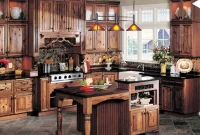Welcome to “The Ultimate Guide to Kitchen Set Maintenance”. In this article, we will provide you with valuable insights and tips on how to effectively maintain your kitchen set to ensure its longevity and functionality. Whether you have a traditional or modern kitchen, these expert recommendations will help keep your kitchen set looking and performing its best. Let’s dive in!
Routine Cleaning Tips for Kitchen Sets
Keeping your kitchen set clean is essential for maintaining a hygienic and inviting cooking space. Here are some tips to help you maintain the cleanliness and durability of your kitchen set:
1. Clear the Clutter
Start by removing all unnecessary items from your kitchen set. Clear off the countertops, cabinets, and drawers, and only keep the essential items. This will make it easier to clean and prevent the accumulation of unnecessary dirt and grime.
2. Wipe Down Countertops and Surfaces
Regularly wipe down your countertops and other surfaces with a mild cleaning solution. Use a microfiber cloth or sponge to remove any food debris, spills, or stains. Avoid using abrasive cleaners that can damage the surface of your kitchen set.
3. Clean the Sink
Keep your sink clean and free from bacteria by regularly washing it with warm soapy water. Scrub the sink using a soft cloth or sponge, paying extra attention to the drain and faucet. To remove limescale or stubborn stains, use a mixture of vinegar and water.
4. Degrease Your Range Hood
The range hood can collect a lot of grease over time. Remove the filters and soak them in warm soapy water. Scrub off any grease or residue and let them dry before putting them back in. Wipe down the exterior of the range hood with a degreaser to remove any built-up grease.
5. Clean the Cabinets and Drawers
Regularly clean the interior and exterior of your cabinets and drawers. Use a mild detergent and warm water to wipe down the surfaces. Remove any crumbs or spills that may have accumulated and organize the contents to avoid clutter.
6. Maintain the Appliances
Follow the manufacturer’s instructions to clean and maintain your kitchen appliances. Regularly clean the oven, stove, refrigerator, and dishwasher to prevent the build-up of dirt and grime. Pay attention to the filters and vents, and replace them when necessary.
7. Sweep and Mop the Floors
Clean the kitchen floors regularly by sweeping away crumbs and debris. Use a mop and a mild floor cleaner to remove any stains or spills. Focus on high-traffic areas and underneath appliances to ensure a thorough clean.
By following these routine cleaning tips, you can keep your kitchen set looking its best and ensure a clean and healthy cooking environment.
Protecting Surfaces from Wear and Tear
When it comes to maintaining your kitchen set, one of the key aspects is protecting its surfaces from wear and tear. Constant use, spills, and scratches can all contribute to the deterioration of your kitchen set over time. By implementing a few simple practices, you can extend the lifespan of your kitchen set and keep it looking pristine for years to come.
1. Use Cutting Boards and Trivets
Prevent scratches and heat damage on your kitchen countertops by using cutting boards and trivets. Cutting boards provide a protective barrier between your knives and the surface, while trivets protect against hot pots and pans. Opt for cutting boards made of materials such as wood or plastic, and choose trivets that are heat-resistant and durable.
2. Clean Spills Immediately
Spills are inevitable in the kitchen, but leaving them unattended can lead to stains and damage. Clean up spills as soon as they occur to prevent them from seeping into porous surfaces or causing discoloration. Use mild cleaning agents and soft clothes or sponges to avoid scratching or harming the finish.
3. Avoid Harsh Chemicals
When cleaning your kitchen set, avoid using harsh chemicals that can strip away the protective coatings or cause discoloration. Instead, opt for gentle cleaning solutions specifically designed for the type of surface you are cleaning. Always follow the manufacturer’s instructions to ensure you use the proper cleaning method.
4. Regularly Maintain and Seal
Depending on the material of your kitchen set, it may require regular maintenance and sealing. For example, wooden surfaces may benefit from periodic oiling or varnishing to protect against moisture and prevent drying or cracking. Granite or marble countertops may require resealing to maintain their shine and resist staining.
5. Use Protective Coatings
If you want to provide an extra layer of protection to your kitchen set, consider using protective coatings. There are various coatings available in the market that can add a durable and resistant finish to your surfaces. Consult a professional or do thorough research to find the most suitable coating for your specific needs.
By following these practices, you can ensure that your kitchen set remains in excellent condition throughout its lifespan. Remember, prevention is key when it comes to protecting surfaces from wear and tear. By taking proactive steps, you can enjoy a beautiful and well-maintained kitchen for years to come.
Organizational Hacks for Kitchen Longevity
When it comes to maintaining your kitchen set, organization is key. A well-organized kitchen not only facilitates efficient cooking and meal preparation but also extends the longevity of your kitchen equipment. Here are some essential organizational hacks to help you keep your kitchen in top condition:
Create Dedicated Zones
Designate specific zones within your kitchen for different tasks, such as cooking, prepping, and cleaning. By keeping these areas separate, you can minimize clutter and ensure that each activity has its dedicated space.
Use Storage Containers
Invest in clear and stackable storage containers to store dry ingredients, spices, and other pantry items. These containers not only keep your food fresh but also make it easier to locate and access ingredients when needed.
Implement Vertical Storage
Maximize your kitchen’s storage potential by utilizing vertical space. Install wall-mounted shelves or hooks to hang pots, pans, and utensils. This not only saves drawer and cabinet space but also allows for easier access to frequently used items.
Label Everything
Labeling is essential to maintain order in your kitchen. Use labels on containers, shelves, and drawers to identify their contents. This way, you can quickly find what you need without rummaging through numerous items.
Establish a Cleaning Routine
Maintaining a clean kitchen is crucial for its longevity. Establish a regular cleaning routine to ensure that appliances, countertops, and utensils are consistently sanitized. Regularly deep clean your kitchen to prevent the buildup of grease and grime in hard-to-reach areas.
Organize Cabinets and Drawers
Arrange your cabinets and drawers according to functionality. Group similar items together, such as pots with lids or baking sheets with cooling racks. Utilize drawer dividers or inserts to keep utensils neatly organized and easy to find.
Regularly Check for Maintenance Needs
Perform regular checks on your kitchen appliances and fixtures to identify any maintenance needs. Inspect for leaks, loose fittings, or signs of wear and tear. Addressing these issues promptly can prevent further damage and ensure the longevity of your kitchen equipment.
By implementing these organizational hacks, you can create a functional and well-maintained kitchen set that will stand the test of time. Remember, a clutter-free and organized kitchen not only enhances your cooking experience but also contributes to the longevity of your kitchen equipment.
Professional Care and When to Seek It
When it comes to maintaining your kitchen set, it is essential to understand when it is necessary to seek professional care. While regular cleaning and maintenance can keep your kitchen set in good condition, there are situations where professional assistance becomes beneficial.
1. Malfunctioning Appliances
If your kitchen appliances are not functioning properly, it is recommended to seek professional assistance. Faulty appliances can be a safety hazard and may require specialized knowledge for repairs. Professional technicians have the expertise to diagnose and fix problems effectively.
2. Persistent Plumbing Issues
When you encounter persistent plumbing issues, it’s time to call a professional plumber. Leaky faucets, clogged pipes, or low water pressure can be signs of an underlying problem. A qualified plumber can identify the root cause and provide the necessary solutions to avoid further damage.
3. Difficult Kitchen Set Repairs
For complex kitchen set repairs that require advanced skills or specialized tools, it is wise to hire a professional. This includes tasks such as cabinet refacing, countertop replacement, or intricate wiring. Professionals can ensure the work is done correctly and efficiently, saving you time and potential headaches.
4. Safety Inspections
To ensure your kitchen set meets safety standards, it is advised to schedule periodic inspections by professionals. They can identify potential hazards, like faulty electrical wiring or gas leaks, that may pose risks to you and your household.
Remember, DIY maintenance can be an excellent way to keep your kitchen set in top shape, but knowing when to seek professional care is crucial. By addressing problems promptly and employing the expertise of professionals when needed, you can ensure a well-maintained and safe kitchen set for years to come.
Conclusion
In conclusion, proper kitchen set maintenance is vital to preserving its functionality and aesthetic appeal. Regular cleaning, avoiding harsh chemicals, and addressing any damages promptly can significantly extend the lifespan of your kitchen set. By adhering to these guidelines, you can ensure that your kitchen set remains in top condition for years to come.



